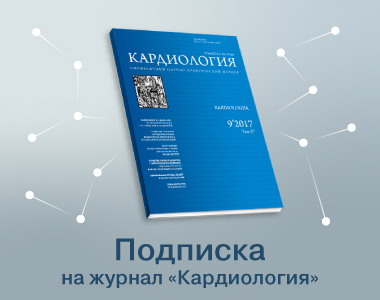“Ictal” Bradyarrhythmias in Patients with Drug-Resistant Epilepsy: Results of Long-Term Heart Rhythm Monitoring
https://doi.org/10.18087/cardio.2020.12.n1379
Abstract
Aim To determine the type and incidence of ictal bradyarrhythmias in patients with drug-resistant types of epilepsy by long-term electrocardiogram (ECG) monitoring.
Material and methods Subcutaneous ECG monitors programed for recording pauses >3 sec and episodes of bradycardia ≤45 bpm were implanted in 193 patients with persistent epileptic seizures without organic pathology of the myocardium. Recording was activated by the patient/family at the onset of epileptic seizure. The follow-up period was 36 months with visits to the clinic every three months.
Results For 36 months of monitoring, 6494 ECG fragments were recorded. Ictal bradycardia was observed in 6.7 % of patients, including ictal asystole in 2.6 % of patients. Episodes of bradycardia and asystole during epileptic seizures were transient and developed significantly more frequently in men, patients with long duration of the disease, bilateral tonic-clonic or focal seizures with disorder of consciousness, during sleep, on the background of treatment with several antiepileptic agents, mostly from the group of potassium channel blockers.
Conclusion Bradyarrhythmias accompanying epileptic seizures are transient and reproducible from seizure to seizure. They reflect functional changes in the myocardium and do not determine the life prediction for patients with epilepsy without organic pathology of the heart.
Keywords
About the Authors
S. E. SerdyukRussian Federation
Cardiac Arrhythmia Department, Senior researcher, Candidate of Medical Sciences
K. V. Davtyan
Russian Federation
Cardiac Arrhythmia Department, Head of department, Doctor of Medical Sciences
S. G. Burd
Russian Federation
Department of Neurology, Professor, Doctor of Medical Sciences
E. S. Mishina
Russian Federation
Cardiac Arrhythmia Department, Postgraduate
O. M. Drapkina
Russian Federation
Corresponding member RAMS, Professor, Doctor of Medical Sciences, Director of The National Medical Research Center for Preventive Medicine
E. I. Gusev
Russian Federation
Corresponding member RAS, Professor, Doctor of Medical Sciences, Head of the Department of Neurology, Neurosurgery and Medical Genetics
References
1. Feigin VL, Nichols E, Alam T, Bannick MS, Beghi E, Blake N et al. Global, regional, and national burden of neurological disorders, 1990– 2016: a systematic analysis for the Global Burden of Disease Study 2016. The Lancet Neurology. 2019;18(5):459–80. DOI: 10.1016/S1474-4422(18)30499-X
2. Thurman DJ, Beghi E, Begley CE, Berg AT, Buchhalter JR, Ding D et al. Standards for epidemiologic studies and surveillance of epilepsy: Standards for Epidemiologic Studies and Surveillance of Epilepsy. Epilepsia. 2011;52(Suppl 7):2–26. DOI: 10.1111/j.1528-1167.2011.03121.x
3. van der Lende M, Surges R, Sander JW, Thijs RD. Cardiac arrhythmias during or after epileptic seizures. Journal of Neurology, Neurosurgery & Psychiatry. 2016;87(1):69–74. DOI: 10.1136/jnnp-2015-310559
4. Casciato S, Quarato PP, Mascia A, D’Aniello A, Esposito V, Morace R et al. Ictal Asystole in Drug-Resistant Focal Epilepsy: Two Decades of Experience from an Epilepsy Monitoring Unit. Brain Sciences. 2020;10(7):443. DOI: 10.3390/brainsci10070443
5. Newey CR, Sarwal A. Ictal Asystole in Focal Epilepsy: To Pace or Not to Pace? The Neurohospitalist. 2015;5(4):NP3–6. DOI: 10.1177/1941874415569070
6. Schuele SU, Bermeo AC, Alexopoulos AV, Locatelli ER, Burgess RC, Dinner DS et al. Video-electrographic and clinical features in patients with ictal asystole. Neurology. 2007;69(5):434–41. DOI: 10.1212/01.wnl.0000266595.77885.7f
7. Chen W, Guo C-L, Zhang P-S, Liu C, Qiao H, Zhang J-G et al. Heart rate changes in partial seizures: analysis of influencing factors among refractory patients. BMC Neurology. 2014;14(1):135. DOI: 10.1186/1471-2377-14-135
8. Stecker EC, Reinier K, Uy-Evanado A, Teodorescu C, Chugh H, Gunson K et al. Relationship Between Seizure Episode and Sudden Cardiac Arrest in Patients With Epilepsy: A Community-Based Study. Circulation: Arrhythmia and Electrophysiology. 2013;6(5):912–6. DOI: 10.1161/CIRCEP.113.000544
9. Duplyakov D, Golovina G, Lyukshina N, Surkova E, Elger CE, Surges R. Syncope, seizure-induced bradycardia and asystole: Two cases and review of clinical and pathophysiological features. Seizure. 2014;23(7):506–11. DOI: 10.1016/j.seizure.2014.03.004
10. Mbizvo GK, Derry C, Davenport R. Ictal asystole: a diagnostic and management conundrum. Journal of the Royal College of Physicians of Edinburgh. 2019;49(2):128–31. DOI: 10.4997/JRCPE.2019.209
11. Lanz M, Oehl B, Brandt A, Schulze-Bonhage A. Seizure induced cardiac asystole in epilepsy patients undergoing long term videoEEG monitoring. Seizure. 2011;20(2):167–72. DOI: 10.1016/j.seizure.2010.11.017
12. Velagapudi P, Turagam M, Laurence T, Kocheril A. Cardiac Arrhythmias and Sudden Unexpected Death in Epilepsy (SUDEP). Pacing and Clinical Electrophysiology. 2012;35(3):363–70. DOI: 10.1111/j.1540-8159.2011.03276.x
13. Vilella L, Lacuey N, Hampson JP, Rani MRS, Loparo K, Sainju RK et al. Incidence, Recurrence, and Risk Factors for Peri-ictal Central Apnea and Sudden Unexpected Death in Epilepsy. Frontiers in Neurology. 2019;10:166. DOI: 10.3389/fneur.2019.00166
14. Kerling F, Dütsch M, Linke R, Kuwert T, Stefan H, Hilz MJ. Relation between ictal asystole and cardiac sympathetic dysfunction shown by MIBG-SPECT. Acta Neurologica Scandinavica. 2009;120(2):123– 9. DOI: 10.1111/j.1600-0404.2008.01135.x
15. Thijs RD. The autonomic signatures of epilepsy: diagnostic clues and novel treatment avenues. Clinical Autonomic Research. 2019;29(2):131–3. DOI: 10.1007/s10286-019-00603-1
16. Ferrie CD. Preventing misdiagnosis of epilepsy. Archives of Disease in Childhood. 2006;91(3):206–9. DOI: 10.1136/ adc.2005.088906
17. Baraldi S, Farrell F, Benson J, Diehl B, Wehner T, Kovac S. Drop attacks, falls and atonic seizures in the Video-EEG monitoring unit. Seizure. 2015;32:4–8. DOI: 10.1016/j.seizure.2015.08.001
18. Lempert T, Bauer M, Schmidt D. Syncope: A videometric analysis of 56 episodes of transient cerebral hypoxia. Annals of Neurology. 1994;36(2):233–7. DOI: 10.1002/ana.410360217
19. van Dijk JG, van Rossum IA, Thijs RD. Timing of Circulatory and Neurological Events in Syncope. Frontiers in Cardiovascular Medicine. 2020;7:36. DOI: 10.3389/fcvm.2020.00036
20. Bergfeldt L. Differential diagnosis of cardiogenic syncope and seizure disorders. Heart. 2003;89(3):353–8. DOI: 10.1136/heart.89.3.353
21. Leung H, Kwan P, Elger CE. Finding the missing link between ictal bradyarrhythmia, ictal asystole, and sudden unexpected death in epilepsy. Epilepsy & Behavior. 2006;9(1):19–30. DOI: 10.1016/j.yebeh.2006.05.009
Review
For citations:
Serdyuk S.E., Davtyan K.V., Burd S.G., Mishina E.S., Drapkina O.M., Gusev E.I. “Ictal” Bradyarrhythmias in Patients with Drug-Resistant Epilepsy: Results of Long-Term Heart Rhythm Monitoring. Kardiologiia. 2020;60(12):90-96. https://doi.org/10.18087/cardio.2020.12.n1379
















